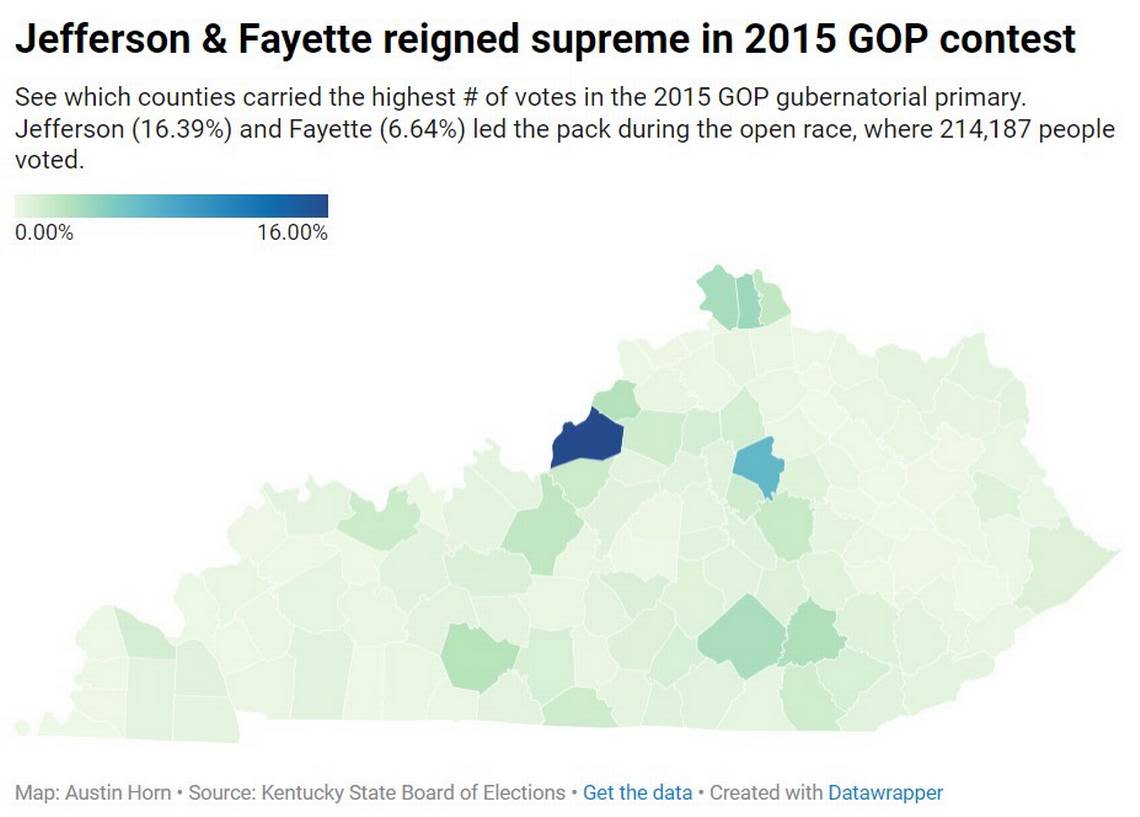Here are the counties to watch in KY’s GOP primary for governor. A lot has changed.

The path to the GOP nomination for statewide elected office has often run through Jefferson County, Fayette County and South-Central Kentucky. But now with growth in GOP registration across the state, that’s changing.
There’s a new set of highly important counties — thanks to high voter conversion or population growth — to watch on Election Night.
Urban counties like Fayette and Jefferson are losing influence among the GOP electorate, and many suburban counties and rural counties in the state’s East and West are picking up the slack.
These trends could change the political calculus for governor candidates since the last competitive GOP gubernatorial primary – in 2015 when former governor Matt Bevin beat now-U.S. Rep. James Comer by a mere 83 votes.
The dynamic is clearly trending away from Jefferson and Fayette counties and towards most of the state’s other 118 counties. However, the state’s two largest counties still hold the greatest share of registered GOP voters at 12.49% and 5.25%, respectively. Trailing them are the Northern Kentucky counties of Kenton and Boone at 4.2% and 3.89%, followed by the I-65 counties of Warren and Hardin at 2.57% and 2.45% of the GOP electorate.
A county’s share of the GOP electorate is calculated by dividing their total number of Republicans registered to vote by the total number in the state. So while a county like Jefferson has grown its GOP ranks from 182,000 in 2015 to 198,000 in 2023, its 2023 total is less important to office-seekers than the 2015 number because the party has grown at a much faster rate elsewhere in the state.
While Fayette and Jefferson have become less relevant, many of their immediate surrounding suburban counties like Madison and Bullitt – high-growth counties where many voters have converted to the GOP – are becoming more important. Madison and Bullitt counties lead the rankings of counties that have gained the highest share of the GOP electorate since 2015. Madison rose from a 1.92% share to 2.24% – the biggest jump of any county in Kentucky – while Bullitt rose from 1.86% to 2.11%.
Many traditionally ruby red counties have become somewhat less relevant in the overall electorate. Laurel and Pulaski counties, long anchors for the GOP in Kentucky, each lost about 0.3% of their share of the Republican electorate. Unlike many other counties, the vast majority of those voters were already Republican.
Traditionally Democratic parts of Eastern and Western Kentucky are also much more important for GOP nominations now. Counties like Graves in the West and Harlan in the East have nearly doubled their Republican registration since April 2015. McCracken and Marshall in the state’s Purchase Region and Pike and Floyd counties in the Eastern coalfields gained many GOP voters since then, often in spite of stagnant or dwindling population growth trends.
The last open race saw Jefferson punch slightly above its weight in terms of turnout, with 16.4% of the vote coming from Kentucky’s most populous county, though its share of the registered voters was 14.7%. Two top candidates, Bevin businessman Hal Heiner, were from Jefferson. Similarly, Monroe County came out strong for Comer. The relatively small county on the state’s Southern border accounted for 1.55% of the vote, despite having only 0.58% of the state’s registered GOP voters. Their intense support of Comer nearly pushed him over the edge against Bevin.
It’s possible that home counties could play a role in this gubernatorial election as well.
Attorney General Daniel Cameron is from Hardin County but lives in Jefferson and former U.S. ambassador to the United Nations Kelly Craft is from Barren County but lives in Fayette. Commissioner of Agriculture Ryan Quarles is from Scott County and conservative activist Eric Deters is from Kenton County. It’s possible, too, that Auditor Mike Harmon or Somerset Mayor Alan Keck could boost turnout in their home counties of Boyle and Pulaski.
Kentucky Voter Guide: Here’s everything you need to know about the primary elections


